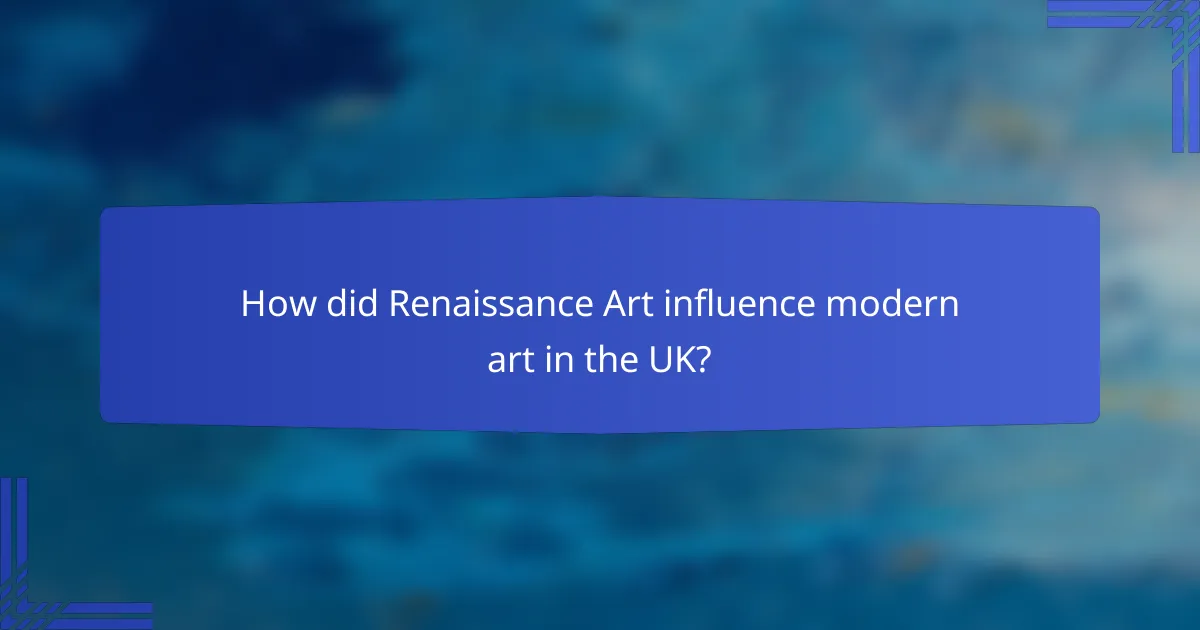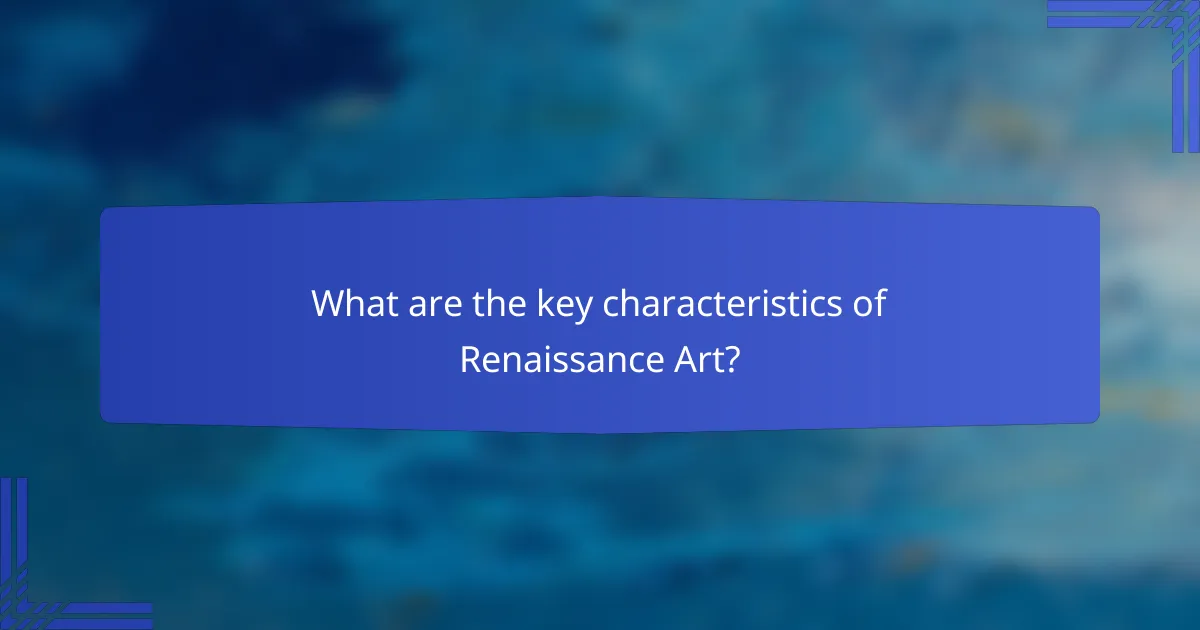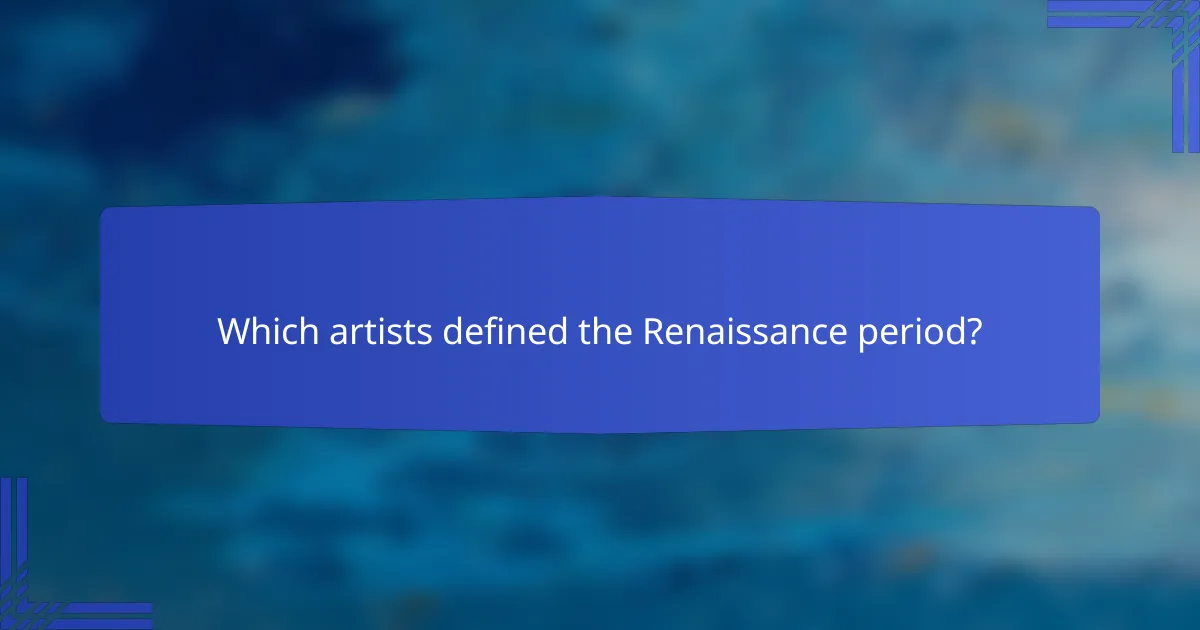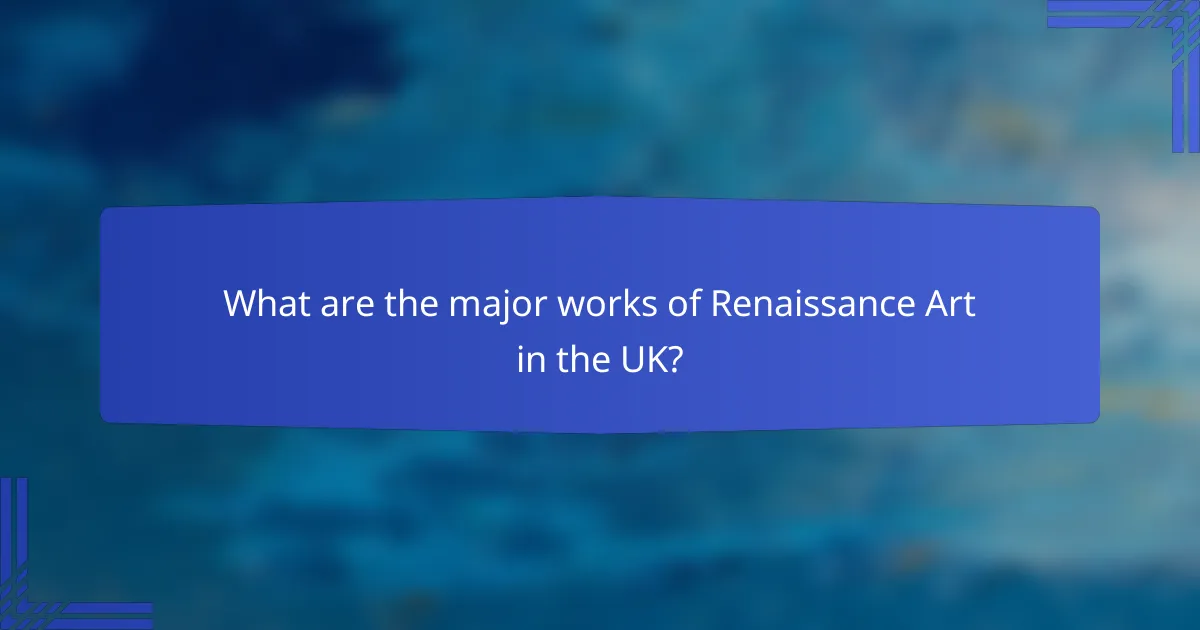Renaissance art marked a transformative period in the history of art, characterized by a revival of classical themes and a strong emphasis on humanism. Artists of this era, such as Leonardo da Vinci and Michelangelo, sought to depict the human experience and the natural world with remarkable accuracy and emotional depth, employing detailed realism that set new standards for artistic expression.

How did Renaissance Art influence modern art in the UK?
Renaissance art significantly shaped modern art in the UK by introducing classical themes, emphasizing humanism, and employing techniques of detailed realism. These elements laid the groundwork for artistic expression that continues to resonate in contemporary works.
Adoption of classical themes
Renaissance artists drew inspiration from ancient Greek and Roman art, which emphasized beauty, proportion, and harmony. This adoption of classical themes encouraged modern UK artists to explore similar ideals, resulting in a focus on symmetry and balance in their works.
For example, the use of mythological subjects and historical narratives became prevalent in British art, reflecting a revival of classical storytelling. Artists like Sir Joshua Reynolds and Thomas Gainsborough incorporated these themes, bridging the gap between past and present artistic expressions.
Emphasis on humanism
The Renaissance marked a shift towards humanism, which prioritized human experience and individualism. This emphasis influenced modern UK art by encouraging artists to depict the human condition with greater depth and emotion.
Contemporary artists often explore themes of identity, society, and personal experience, echoing the humanist values of the Renaissance. The portrayal of realistic human figures and expressions became a hallmark of British art, allowing for a more relatable connection with viewers.
Techniques of detailed realism
Renaissance artists perfected techniques such as linear perspective and chiaroscuro, which enhanced the realism of their work. These methods have had a lasting impact on modern art in the UK, as artists continue to employ similar techniques to create depth and dimension.
For instance, the meticulous attention to detail seen in the works of artists like John Constable and J.M.W. Turner reflects the legacy of Renaissance realism. Modern artists often strive for a similar level of detail, using advanced tools and methods to achieve lifelike representations in their art.

What are the key characteristics of Renaissance Art?
Renaissance Art is characterized by a revival of classical themes, an emphasis on humanism, and a commitment to detailed realism. Artists sought to capture the human experience and the natural world with unprecedented accuracy and emotional depth.
Use of perspective
Perspective in Renaissance Art revolutionized how depth and space were represented on a flat surface. Artists like Filippo Brunelleschi developed linear perspective techniques, allowing for a more realistic portrayal of three-dimensional space. This technique involved creating a vanishing point on the horizon line, where parallel lines converge, enhancing the illusion of depth.
To effectively use perspective, artists often employed a grid system to maintain proportions and angles. This method not only added realism but also guided the viewer’s eye through the composition, creating a more immersive experience.
Naturalism in human figures
Naturalism in human figures marked a significant shift from the stylized forms of earlier periods. Renaissance artists studied anatomy and used live models to achieve accurate representations of the human body. This focus on realism allowed for more expressive and dynamic poses, reflecting a deeper understanding of human emotion and movement.
For example, Leonardo da Vinci’s “Vitruvian Man” exemplifies this commitment to anatomical precision and proportion. Artists aimed to depict not just the physical form but also the character and emotion of their subjects, resulting in more relatable and engaging artwork.
Religious and mythological themes
Renaissance Art frequently explored religious and mythological themes, reflecting the era’s cultural and intellectual revival. Artists like Michelangelo and Raphael created works that depicted biblical stories and classical myths, often infusing them with humanist ideals. These themes allowed artists to convey moral and philosophical messages while showcasing their technical skills.
In many cases, religious subjects were rendered with a sense of realism and emotional depth, inviting viewers to connect with the narratives on a personal level. Mythological themes, such as those found in Botticelli’s “The Birth of Venus,” celebrated beauty and human experience, further bridging the gap between the divine and the earthly.

Which artists defined the Renaissance period?
The Renaissance period was defined by several key artists who significantly influenced art through their innovative techniques and themes. Notable figures include Leonardo da Vinci, Michelangelo, and Raphael, each contributing to the movement’s focus on classical themes, humanism, and detailed realism.
Leonardo da Vinci
Leonardo da Vinci was a quintessential Renaissance artist known for his mastery of various disciplines, including painting, sculpture, and engineering. His works, such as the “Mona Lisa” and “The Last Supper,” exemplify the use of perspective and human emotion, showcasing a deep understanding of anatomy and light.
Da Vinci’s approach to art was characterized by meticulous observation and experimentation. He often employed techniques like sfumato, which creates a soft transition between colors, enhancing the realism of his subjects. His notebooks reveal a relentless curiosity about the natural world, influencing countless artists after him.
Michelangelo
Michelangelo was a master sculptor and painter whose works are iconic representations of Renaissance art. His sculptures, such as “David” and the “Pietà,” demonstrate an extraordinary ability to convey human emotion and physical form, emphasizing the beauty of the human body.
In addition to sculpture, Michelangelo’s frescoes on the ceiling of the Sistine Chapel are monumental achievements in art history. His use of vibrant colors and dynamic poses reflects the Renaissance ideals of humanism and the celebration of human potential, making his contributions essential to the period.
Raphael
Raphael is celebrated for his harmonious compositions and clarity of form, which epitomize the ideals of the Renaissance. His famous works, such as “The School of Athens,” showcase a blend of classical philosophy and humanist thought, featuring prominent figures from history and mythology.
Raphael’s ability to create serene and balanced scenes set a standard for future generations of artists. His use of perspective and soft color palettes contributed to the overall aesthetic of Renaissance art, making his work a vital part of the movement’s legacy.

What are the major works of Renaissance Art in the UK?
In the UK, major works of Renaissance art include masterpieces that showcase classical themes, humanism, and detailed realism. Notable examples are housed in various galleries and museums, reflecting the profound impact of Renaissance artists on Western art.
The Last Supper by Leonardo da Vinci
The Last Supper, painted by Leonardo da Vinci in the late 15th century, is a monumental work that depicts the final meal of Jesus with his disciples. This fresco is renowned for its composition and emotional depth, capturing the moment of Jesus announcing his betrayal.
Visitors to the UK can view a replica of The Last Supper at various exhibitions, as the original is located in Milan. The painting’s use of perspective and detailed expressions exemplifies Renaissance ideals of realism and human emotion.
The Sistine Chapel by Michelangelo
The Sistine Chapel, famous for its stunning ceiling painted by Michelangelo, is a hallmark of Renaissance art. Completed in the early 16th century, the ceiling features iconic scenes from the Book of Genesis, including the Creation of Adam.
While the original chapel is in Vatican City, its influence is felt in the UK through numerous reproductions and discussions in art history courses. The intricate details and vibrant colors showcase the mastery of human anatomy and the divine, reflecting the humanist ideals of the Renaissance.
The School of Athens by Raphael
The School of Athens, created by Raphael in the early 16th century, is celebrated for its depiction of classical philosophers and thinkers. This fresco embodies the spirit of the Renaissance, merging classical philosophy with artistic innovation.
In the UK, reproductions and studies of The School of Athens are common in educational settings, highlighting its significance in art history. The work’s balanced composition and use of perspective illustrate the Renaissance focus on harmony and intellectual pursuit.

How does Renaissance Art reflect humanist ideals?
Renaissance Art embodies humanist ideals by emphasizing the value of individual experience and the potential for human achievement. This artistic movement focused on realistic portrayals of the human form and a revival of classical themes, showcasing a deep appreciation for humanity’s capabilities and intellect.
Focus on individualism
Individualism in Renaissance Art is characterized by the portrayal of unique human figures with distinct personalities and emotions. Artists like Leonardo da Vinci and Michelangelo created works that emphasized the human experience, showcasing subjects in a way that highlighted their individuality and inner life.
This focus on individualism marked a departure from the collective representations of the medieval period, where figures were often anonymous and generalized. Instead, Renaissance artists sought to capture the essence of each person, making their works more relatable and engaging to viewers.
Celebration of human achievement
Renaissance Art celebrates human achievement by depicting scenes of historical and mythological significance that highlight human intellect and creativity. Artists often illustrated great thinkers, inventors, and leaders, showcasing their contributions to society and culture.
For example, works like Raphael’s “The School of Athens” not only celebrate intellectual achievement but also symbolize the harmony between classical philosophy and contemporary thought. Such representations inspire admiration for human potential and the pursuit of knowledge.
Integration of classical philosophy
The integration of classical philosophy into Renaissance Art is evident in the revival of themes from ancient Greece and Rome. Artists drew inspiration from classical texts and ideals, incorporating elements such as proportion, perspective, and anatomy to enhance realism in their works.
This blending of classical philosophy with contemporary themes allowed artists to create a dialogue between the past and present, enriching the cultural landscape of the Renaissance. By referencing classical ideals, artists reinforced the importance of human reason and the pursuit of beauty, which were central to humanist thought.

What are the differences between Renaissance and Medieval Art?
Renaissance art differs from Medieval art primarily in its focus on classical themes, humanism, and detailed realism. While Medieval art often emphasized religious subjects and symbolism, Renaissance art sought to capture the human experience and the natural world with greater accuracy and depth.
Classical Themes
Renaissance art revived classical themes from ancient Greece and Rome, showcasing mythology, history, and human figures in dynamic poses. Artists like Raphael and Michelangelo drew inspiration from classical sculptures and literature, integrating these elements into their work to convey a sense of beauty and proportion.
In contrast, Medieval art predominantly focused on biblical narratives and spiritual symbolism, often using flat, two-dimensional representations. This shift towards classical themes marked a significant cultural transition, emphasizing human experience over divine representation.
Humanism
Humanism played a crucial role in Renaissance art, promoting the study of classical texts and the value of human potential. Artists began to depict individuals with distinct personalities and emotions, reflecting a deeper understanding of human nature and society.
Medieval art, however, largely portrayed figures in a more abstract and less individualized manner, often prioritizing religious messages over personal expression. The humanist approach led to more relatable and engaging artworks that resonated with viewers on a personal level.
Detailed Realism
Renaissance artists achieved detailed realism through advancements in techniques such as linear perspective, chiaroscuro, and anatomical accuracy. This focus on realism allowed for more lifelike representations of the human form and the natural environment, as seen in works like Leonardo da Vinci’s “Mona Lisa.”
In contrast, Medieval art often employed stylized forms and lacked depth, resulting in less realistic portrayals. The emphasis on detailed realism during the Renaissance marked a significant evolution in artistic practices, influencing generations of artists to come.
